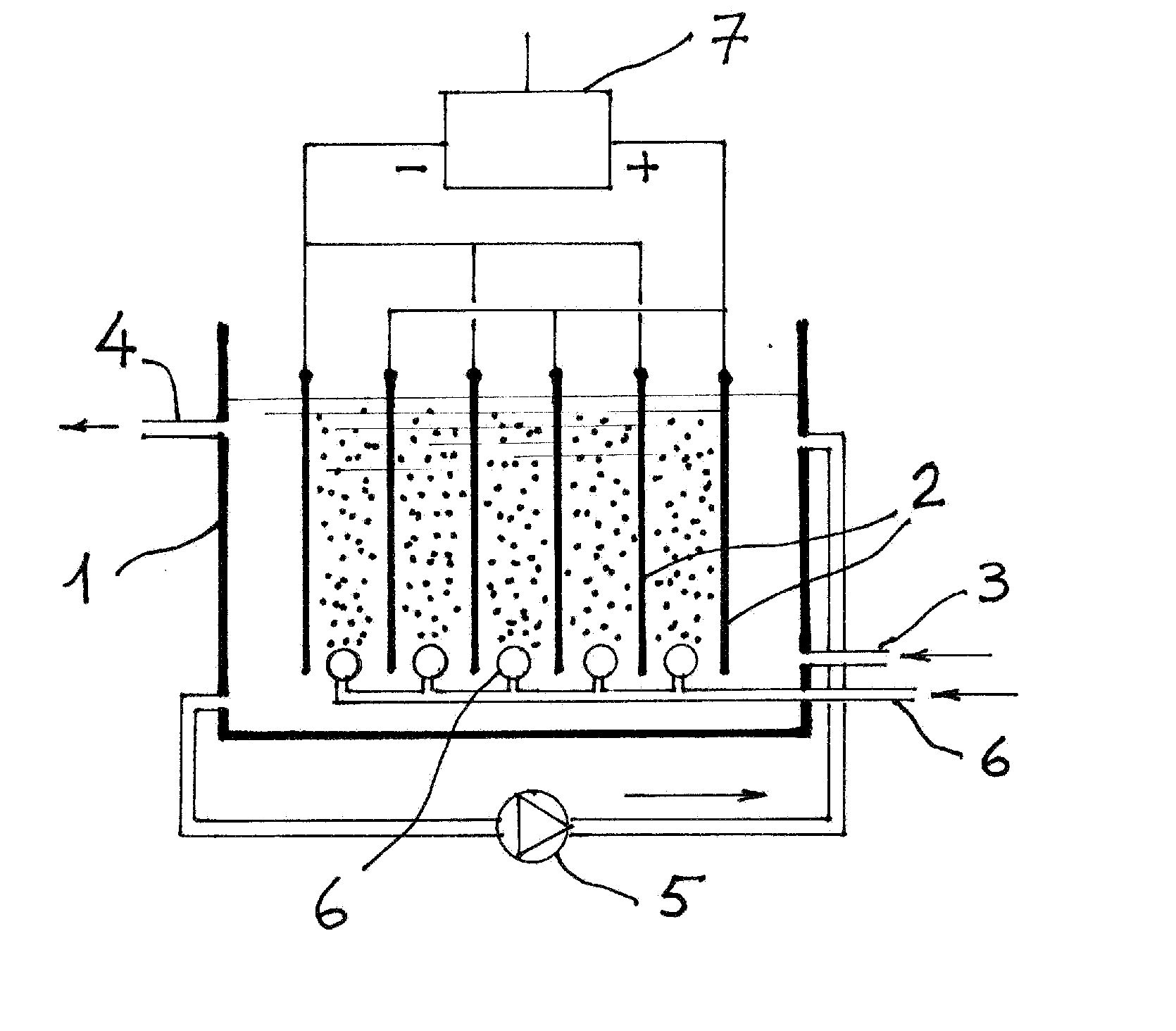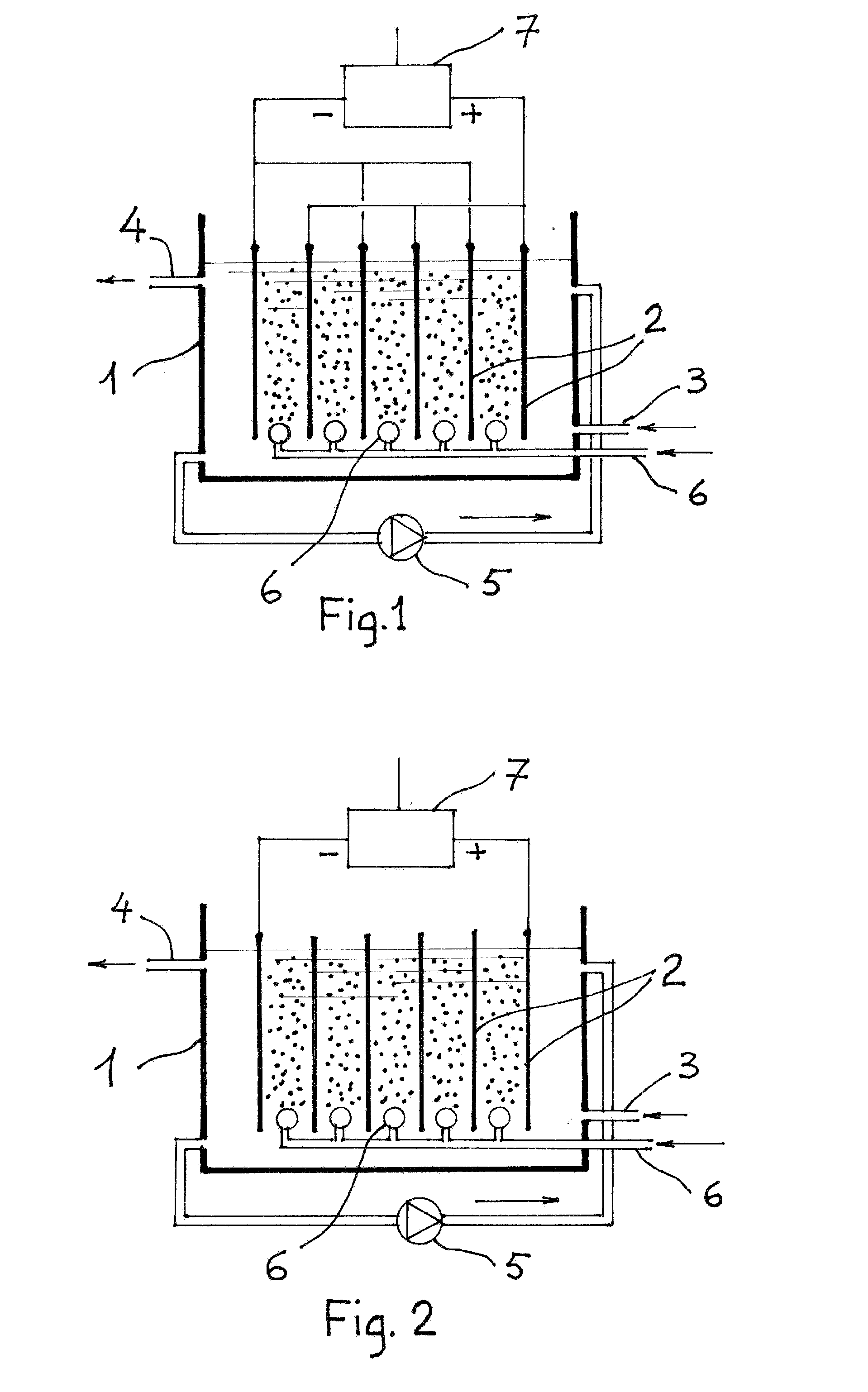Process and method for the removal of arsenic from water
a technology of arsenic and water, applied in water/sludge/sewage treatment, water contaminants, filtration treatment, etc., can solve the problems of high cost, high cost, and high pollution of primary water, and achieve the effect of very efficiently trivalent removal
- Summary
- Abstract
- Description
- Claims
- Application Information
AI Technical Summary
Problems solved by technology
Method used
Image
Examples
experimental examples
Example N.1
[0040]An electrolytic cell was assembled as illustrated in FIG. 1. The electrodes were obtained from commercial mild steel sheet. The anode measured 3.5×7 cm. Facing two identical cathodes of the same size. The resulting active area was therefore 49 cm2. The gap between anode and the two cathodes was 4.0 mm. The electrodes were place vertically in an insulating container. At the base and under the electrodes a ceramic porous candle was placed and connected by means of a flexible plastic tube and flow meter to a compressed air supply. The test water to be spiked with arsenic had the following characteristic:
[0041]pH=7.08; hardness=49.3° F.; conductivity=590 μS; D.O.=5.6 mgL−1 at 17.6° C.;
[0042]Ca 110 mgL−1; NO3 59.7 mgL−1; SO4 88 mgL−1; Fe (total) 14 μL−1; Mn 1.0 μgL−1; Mg 52.7 mgL−1. This water was then spiked with Sodium Arsenite resulting a total As concentration of 1.1 mgL−1. The speciation gave 1.046 mgL−1 of As(III), the spiked water thus contained only 54 μgL−1 of A...
example n.2
[0047]Based on this results a small pilot plant has been assembled. The main parts are: the electrolytic cell made of two disc shaped perforated steel plates, placed horizontally (air bubbles pumped through a ceramic diffuser cross the two perforated electrodes); an upflow gravel flocculator and a sand filter. Flow rate can be varied from 10 to 100 1 / h. In the following tests flow was set at 501 / h. The hydraulic residence time in the electrolytic cell was 4.5 min. The water used for this experiment was the same as the one for the first experiment: it was first deoxygenated and then spiked with Sodium Arsenite (NaASO2) to the concentrations shown in the first column of the table below. Here are the results of a series of preliminary tests.
AsAsAsInputconcentrationconcentrationconcentration atwaterFeFeimmediatelywater filteredflocculator and sandAs(III)concentrationyieldafter filtrationafter 1 hourfilter output, μg / Lμg / Lmg / Lmg / hμg / Lμg / L(% removal)93728.914451234244 (95.3%)63616.1580710...
PUM
| Property | Measurement | Unit |
|---|---|---|
| concentration | aaaaa | aaaaa |
| current density | aaaaa | aaaaa |
| density | aaaaa | aaaaa |
Abstract
Description
Claims
Application Information
 Login to View More
Login to View More - R&D
- Intellectual Property
- Life Sciences
- Materials
- Tech Scout
- Unparalleled Data Quality
- Higher Quality Content
- 60% Fewer Hallucinations
Browse by: Latest US Patents, China's latest patents, Technical Efficacy Thesaurus, Application Domain, Technology Topic, Popular Technical Reports.
© 2025 PatSnap. All rights reserved.Legal|Privacy policy|Modern Slavery Act Transparency Statement|Sitemap|About US| Contact US: help@patsnap.com


